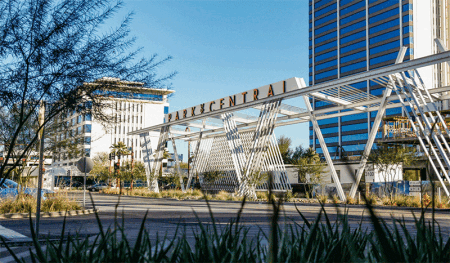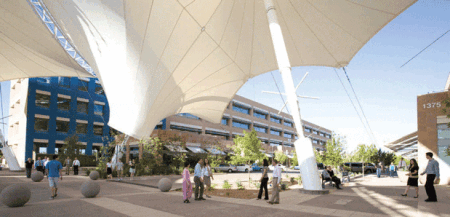
Arizona developer Plaza Companies is focused on healthy buildings that offer fresh air, light, and connectivity with nature, with features like roll-up doors and outdoor workspaces. These amenities are featured at Park Central, the redeveloped Park Central Mall in Phoenix, another mixed-use, public/private collaboration—this one with the Creighton University Health Sciences Campus—and slated for phase-one completion in 2021.
With Arizona continuing to be among the U.S. leaders in job growth, several of the state’s most successful retail, office, and mixed-use residential developers discussed the opportunities of the past decade and the types of commercial development the state will see in the future during ULI Arizona’s 15th annual Trends Day in Phoenix.
“It’s been a decade of disruption and chaos in the retail industry, but that opened the door to new opportunities,” said David Scholl, a founder and partner at Phoenix-based Vintage Partners, a developer of malls and lifestyle centers. In North Central Phoenix, Vintage Partners re-created a tired strip mall as Uptown Plaza, with iconic midcentury modern design, new outdoor spaces, and national and local tenants that include upscale shops, a day spa, and eateries such as Shake Shack and Flower Child.
“Arizona will continue to be centered on redevelopment and repositioning,” said Scholl. Citing a prediction that one in four malls will close in the next couple years, he said that with continued shrinkage of the retail sector, “there won’t be much demand for new retail space. It will be all about repurposing.” Class A malls are “bombproof,” he said; adding mixed uses to class B suburban malls “will provide a lot of opportunity in the future.”
Access content from hundreds of annual ULI events in Knowledge Finder.
Sharon Harper, chief executive officer and chairman of Plaza Companies in Phoenix, said an innovative public/private partnership with the city of Scottsdale, Arizona State University (ASU), Plaza Companies, and real estate investment firm Holualoa led to the development SkySong–the ASU Scottsdale Innovation Center, which has produced $365 million in tax revenue in the region and become “a magnet for good jobs.”
Master developed by Plaza Companies, SkySong is located on 42 acres (17 ha) of the demolished Los Arcos Mall site in Scottsdale. At buildout, SkySong will have 1.2 million square (111,000 sq m) feet of commercial office. To date, 750,000 square feet (70,000 sq m) of space houses about 50 companies employing more than 2,000 employees in businesses ranging from startups to Fortune 500s companies, as well as an Element hotel by Marriott and apartments. Buildings are organized around a central plaza that has a signature shade structure, as well as a grand boulevard with restaurants along Scottsdale Road. The project’s success is due to “a vision, the right partners, and a plan to really transform an area,” Harper said.
“We’ve had unbelievable growth in Arizona, but we need to attract good, high-wage jobs” as a key to resilience, Harper said.
Plaza Companies is focused on healthy buildings that offer fresh air, light, and connectivity with nature, with features like roll-up doors and outdoor workspaces. These amenities are featured at Park Central, the redeveloped Park Central Mall in Phoenix, another mixed-use, public/private collaboration—this one with the Creighton University Health Sciences Campus—and slated for phase-one completion in 2021. The trajectory for development in health care, the region’s largest employment sector, is very steep, and some health care institutions will continue to grow in freestanding buildings and retail centers, Harper said.
Mall repurposing is also gaining traction in the Tucson region with the planned redevelopment of several fading malls in and around the city, said Keri Silvyn, partner/owner of Lazarus & Silvyn P.C. in Tucson and Phoenix. The company specializes in land use, zoning, and entitlement.

From left to right: Steve Betts, founder and president, Betts Real Estate Advisors; David Krumwiede, executive vice president, Lincoln Property Company; Sharon Harper, president and CEO, Plaza Companies; Keri Silvyn, partner/owner, Lazarus & Silvyn; and David Scholl, partner, Vintage Partners, speaking at the 2020 ULI Arizona Trends Day.
“Retail centers are turning into true mixed-use [projects],” she said. “We’re adding residential and restaurants and really creating spaces to attract employment, so you have all of that synergized in one place.”
Existing malls are difficult to repurpose, she said, because some are owned and some are leased. “It’s a fascinating puzzle where all properties need to be entitled because of Euclidean zoning where we’ve separated all these uses and now need to bring them together. So partnerships with government are very important.”
Tucson’s downtown has been transformed in the past eight years by a modern streetcar linking to the University of Arizona and over $1 billion in private investment, Silvyn said. Development is coalescing around denser infill, she said, and older office buildings are also being repurposed for mixed uses.
One South Church, a 23-story tower and the largest building in downtown Tucson, is being partially redeveloped to maintain office use on the top floors, and the bottom nine stories are being repositioned for hospitality/hotel use. Though the original plan was to put a second office tower on the block, the current owner is building lower-rise apartments buildings, so within one square city block there will be residential, hospitality, office, and retail uses, plus a street-level restaurant.

An iconic 125-foot-tall (38 m) shade sail at SkySong, the Arizona State University Innovation Center, anchors the 42-acre (17 ha) development and is part of a heat-conscious design that helps attract tenants and reflects the founding partners’ forward-thinking, entrepreneurial vision. (Plaza Companies)
David Krumwiede, executive vice president of Lincoln Property Company (LPC), a commercial real estate developer and owner in several U.S. regions, said that after being engaged in ground-up office development for more than 30 years, he was drawn to do something different. LPC and partner Invesco completed a multimillion-dollar renovation of the historic art deco Luhrs City Center in downtown Phoenix, with an office building, a parking garage, and 16,000 square feet (1,500 sq m) of ground-floor retail space.
The renovation was “like two years of binge-watching This Old House,” he said, but offered “a good opportunity to take an iconic historic property and reposition it with a lot of retail.” In January, LPC sold the center’s second office building, the Luhrs Building, which will be renovated as a boutique hotel.
Lincoln Property is also building in its comfort zone—big new office buildings with plenty of amenities.
“It’s all about human resources—attraction and retention,” said Krumwiede. “Human resources groups are on every tour to decide location of the building. If you can’t fill seats, it’s an unsuccessful location, and you won’t be able to recruit. It’s very competitive.”
In Tempe, LPC is developing the 60-acre (24-ha) Grand at Papago Park Center mixed-use project, which includes eight class A office buildings, two hotels, apartments, retail space, and eateries. The 350,000-square-foot (32,500 sq m) Grand2, recently leased to on-demand food delivery service DoorDash, features a 12,000-square-foot (1,100 sq m) rooftop deck and a 12,000-square-foot ground-floor amenity center with indoor/outdoor eating, Peloton bikes, and conference facilities. Grand3, a 235,000-square-foot (21,800 sq m) office building with a rooftop lounge, fitness center, café, and two-acre (0.8 ha) water feature park, could begin construction later in 2020. Located on the Grand Canal, the Grand is minutes by light-rail from Phoenix Sky Harbor International Airport and Tempe’s Mill Avenue District, which has dining, entertainment, and shopping.
Panel moderator Steve Betts, founder and president of Betts Real Estate Advisors in Phoenix, noted that the industrial sector “has led us out of recession, and it’s no longer your dad’s industrial buildings.”
“E-commerce has changed the whole face of industrial buildings,” responded Krumwiede. “They’re effectively giant employment centers now,” and need parking, clear height, big windows or skylights, and amenities similar to those in office or mixed-use buildings. He predicted more commercial growth in Arizona’s West Valley. “It used to be how far you drive ‘til you qualify, and now it’s how close you can get to ports in L.A. and Long Beach,” he said.




